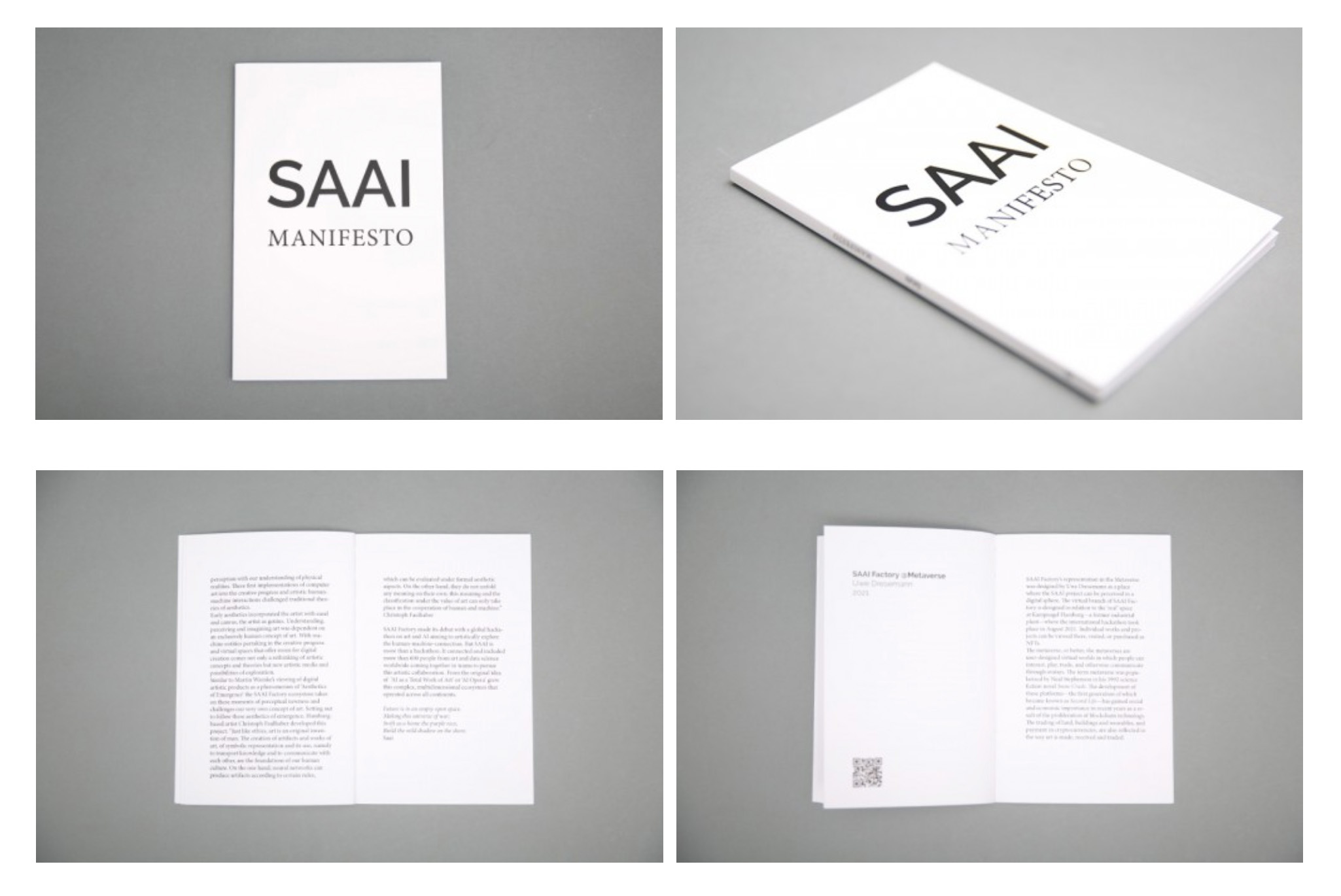SAAI - Super artistic AI MANIFESTO
First Draft (2021)
We live in a world of change, upheaval and crisis. Again, still. Great disruptions have always been accompanied and triggered by a change in the aesthetic regiment and the technological evolution. The arrival of autonomous, non-human agents accelerates the culture war of global postmodernism. Artificial intelligence demands a redefinition of human concepts, such as identity, consciousness, intelligence, ethics, morality, aesthetics, and art.
We need a new form of experience to meet this challenge, one that promotes legibility and understanding, discussion and production of and with artificial intelligence; and the capacity to apply a new cultural technique to a paradigm shift that is emerging in the digital and mental realm: Super Artistic AI as the workbench of a global AI literacy.
The same is true for art as for other forms of cognition, production, and communication; its works or artifacts manifest themselves both inside and outside the material object. Representational systems regulate and determine meaning, understanding, empathy, and emotion. How does this relationship change when two intelligences - the human, biological, and the artificial, logical - enter a space, a stage, together? To what extent can the analogy between the human genetic code and the algorithms of a multilayered neural network be invoked to describe phenomena such as creativity? The structure of our brain and the concept of unsupervised learning provide results that can be as unpredictable and undetermined as they are ambiguous and overdetermined.
Art history and other humanities have often tried to describe the paradigm shift of the epochs in the concept of the "turn": semantic turn, linguistic turn, social turn, spatial turn, iconic turn or provenancial turn. One of the co-founders of the pictorial turn is W. J. T. Mitchell. After September 11, 2001, Mitchell contextualized the images of the collapsing towers and their reproduction in the media with genetic engineering and the first genetically reproduced animal, Dolly the sheep. In his analysis, he draws a connection between the public consciousness and the political situation in which images take on a life of their own: "The current revolutions in biology and computers, and their implications for ethics and politics, raise a host of new questions for which the arts, the traditional humanistic disciplines and Enlightenment modes of rationality may seem ill-prepared. What good is it even to talk about the human if […] we live in a post-human age?“ Mitchell's text "The Work of Art in the Age of Biocybernetic Reproduction“ aims at a vitality and virality of images; he speaks of living images and the anxiety and nervousness that accompany them. Turmoil and unease about autonomous images and their `creators´ continue in today's discussions. Artificial intelligence solidifies the human-machine cosmos and alters production, authorship, ownership, originality, creativity, criticism, and reception.
10 Demands
#1 Mission
SAAI Factory's mission is to reveal the codes and conduct an archaeology of the future, demystify artificial intelligence, debunk illusions, reveal possibilities, spark new thoughts, and make the unexplored fruitful.
#2 Super Artistic AI as a total work of art
Super Artistic AI is part of a new digital ecosystem where essence and existence, capital and community, blockchain and crypto, authors and autonomous agents travel together.
#3 Collaboration and co-creation
With the SAAI Factory we create a space where artists and AI engineers can meet, discuss and jointly explore the field with practical works. Our aim is to address both communities on an equal footing and to involve them in the working and discourse process.
#4 Art, AI and Society
Artificial intelligence is as disruptive as art. AI technologies are having an impact in all areas of society. The history of art shows that it is always a history of protest, resistance, critique of the present, the society and its institutions. In this sense, Super Artistic AI will reflect the relation between art, AI and society, and create a global collective that transcends the pervasive parochialism of the present.
#5 Momentum of Creation
In a special way, artificial intelligence opens the view into the engine room of creation, the moment in which something new comes into being. Super Artistic AI can reproduce, represent, exhibit, experience the artistic topos of "Creatio ex Nihilo". This is a counter position to most „AI Art“ seen today, which seems to follow more mimetic impulses than conceptual drafts.
#6 Looking to the future
Super Artistic AI is the coming together of artistic research and science, artists and AI engineers, working together to push technical capability beyond what is possible. International and interdisciplinary teams will seek new ways to advance art and artificial intelligence as a socially relevant technology.
#7 Interoperability
To the extent that artificial intelligence can analyze and reproduce all kind of human cognition and communication, new forms of interoperability and synesthesia can also be explored.
#8 Synesthesia
Synesthesia is a phenomenon and a strategy for intertwining and linking different art forms. It is transgressive, dissolves boundaries, is an expanded art format. Synesthesia and conviviality of the arts are found in the major forms: Opera, cinema, video games and social sculpture. AI as a total work of art, a Gesamtkunstwerk.
#9 Interaction
Super Artistic AI is a call to advance the possibilities of human-machine interaction, to occupy and play with the interfaces, UI/UX, the layers and nodes of neural networks. A Performance in the mesh of the AI realm.
#10 Ecosystem
Blockchains, DAOs and NFTs are part of an art movement that subjects existing distribution formats to new standards that are decentrally organized. These ecosystems are a countermovement to the existing art market and marketing system. New formats of participatory ownership within the crypto-community show new interpretations of social models such as the „cooperative“, the „commons“ e.a. Now, ephemere artifacts can make their way into the digital ecosystem, such as conceptual art, code, video, performance, immaterial or social practice, relating to new practices of owning, showing and selling.
